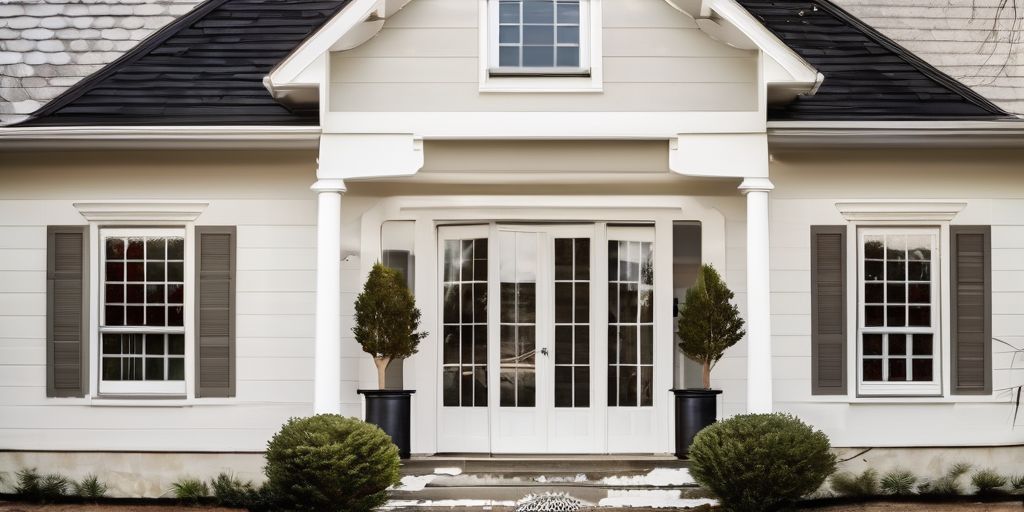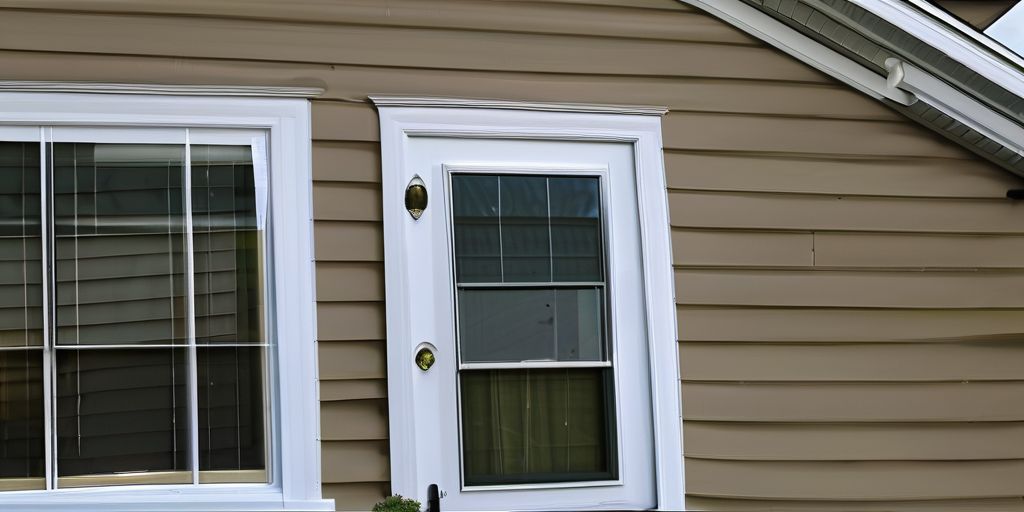Vinyl siding peeling can be unsightly and diminish the overall appeal of your home. By understanding the causes of peeling and taking preventive measures, you can minimize the risk of this issue. Regular maintenance and prompt repairs are essential to ensure the longevity and beauty of your vinyl siding. If the damage is extensive, don’t hesitate to seek professional help or consider replacing your siding. With the right approach, you can restore your home’s exterior and enjoy a well-protected and attractive facade.
Key Takeaways
- Understanding the common causes of vinyl siding paint peeling, including environmental factors, material incompatibility, and installation errors, is crucial for effective prevention and repair.
- Assessing the extent of damage, such as identifying water damage, checking for mold and mildew, and evaluating structural integrity, helps determine the necessary repair steps.
- A step-by-step guide to repairing peeling paint includes cleaning the surface, sanding and smoothing, and applying a fresh coat of paint to restore your siding’s appearance.
- Preventive measures, such as regular cleaning and maintenance, using the right paint and primer, and ensuring proper installation, can help avoid future peeling issues.
- Knowing when to hire a professional for extensive damage or complex repairs ensures that your vinyl siding is properly restored and maintained for long-term durability.
Understanding the Causes of Vinyl Siding Paint Peeling
Vinyl siding is a popular choice among homeowners due to its durability and low maintenance. However, it is not immune to wear and tear. Understanding the root cause of your vinyl siding paint peeling is essential in determining the appropriate solution.
Common Environmental Factors
Environmental factors play a significant role in the peeling of vinyl siding paint. Some of the most common factors include:
- Extreme temperature fluctuations: Vinyl siding expands and contracts with temperature changes, which can lead to peeling if not properly installed.
- Humidity and moisture: High humidity levels and moisture can cause the paint to lose adhesion, leading to peeling.
- Sun exposure: Prolonged exposure to the sun can cause the paint to fade and peel over time.
Material Incompatibility
Using incompatible materials can also result in peeling paint. This includes:
- Incorrect paint type: Not all paints are suitable for vinyl siding. Using the wrong type of paint can lead to poor adhesion and peeling.
- Incompatible primers: Primers that are not designed for use with vinyl siding can cause the paint to peel.
Installation Errors
Improper installation is another common cause of peeling paint on vinyl siding. Some installation errors to watch out for include:
- Insufficient surface preparation: Failing to clean and prepare the surface properly before painting can lead to poor adhesion and peeling.
- Incorrect application techniques: Applying paint too thickly or unevenly can cause it to peel.
- Ignoring manufacturer guidelines: Not following the manufacturer’s instructions for installation and painting can result in peeling paint.
Regular maintenance and prompt repairs are essential to ensure the longevity and beauty of your vinyl siding. If the damage is extensive, don’t hesitate to seek professional help.
By understanding these causes, you can take the necessary steps to prevent and address peeling paint on your vinyl siding.
Assessing the Extent of Damage
Identifying Water Damage
- Look for areas where paint is bubbling or peeling.
- Check for cracks or splits in the siding that may have allowed water to seep through.
- Examine the siding for any signs of mold or mildew, which can indicate moisture problems.
Proper assessment is key to ensuring that all affected areas are addressed to prevent future peeling.
Checking for Mold and Mildew
- Inspect the siding for any dark spots or discoloration.
- Use a mold testing kit if necessary to confirm the presence of mold.
- Clean any mold or mildew with a mixture of water and bleach.
Evaluating Structural Integrity
- Examine the entire surface of your house, looking for peeling, flaking paint, or wet or rotted wood.
- Check that vinyl siding isn’t damaged or that brick isn’t cracked, crumbling, or covered with efflorescence.
- Use a ladder to get a close look at some areas if needed.
Regular maintenance and routine checks can help you avoid costly repairs in the future.
Step-by-Step Guide to Repairing Peeling Paint
Repairing peeling paint on vinyl siding can seem daunting, but with the right approach, you can achieve a professional finish. Follow these steps to revitalize your home’s exterior and enhance curb appeal.
Cleaning the Surface
- Remove the Peeling Paint: Use a putty knife or scraper to gently remove the peeling paint. Be cautious not to damage the underlying surface.
- Clean the Area: Wash the siding with a mild detergent and water to remove dirt and grime. Rinse thoroughly and let it dry completely.
Sanding and Smoothing
- Sand the Surface: Once the peeling paint has been removed, sand the surface to create a smooth and even base for the new paint. Wipe the area with a damp cloth to remove sanding dust.
- Apply Patching Material: Using a putty knife, apply a thin layer of patching material to the damaged area. Allow it to dry completely.
Applying a Fresh Coat of Paint
- Prime the Surface: Apply a high-quality primer suitable for vinyl siding. This step ensures better adhesion of the new paint.
- Paint the Siding: Use a paint specifically designed for vinyl siding. Apply the paint evenly using a brush or roller, following the manufacturer’s instructions.
By following these steps, you’ll create a solid foundation for your paint job, which is essential for preventing future peeling and ensuring long-lasting results. Finish the job with a sealant and establish a regular maintenance routine to keep your siding looking fresh.
Preventive Measures to Avoid Future Peeling
Taking proactive steps to prevent paint peeling can save you time and money in the long run. Here are some measures you can take to avoid facing this issue:
When to Consider Hiring a Professional
Signs You Need Expert Help
While a DIY approach can be rewarding, there are certain situations where professional assistance is essential:
- Safety Concerns: If your vinyl siding is on a multi-story home or you’re uncomfortable working at heights, hiring professionals can ensure your safety.
- Extensive Repairs: If your vinyl siding requires significant repairs before painting, professional expertise can save you time and frustration.
- Persistent Issues: If you’re facing ongoing problems like peeling or managing humidity challenges, it’s wise to seek professional help.
Benefits of Professional Repair
Opting for professional repair services comes with several advantages:
- Expertise and Efficiency: Professionals bring specialized knowledge and tools, ensuring a high-quality finish.
- Time-Saving: Professionals can complete the job faster, allowing you to focus on other tasks.
- Long-Term Results: Professional repairs can extend the life of your siding, reducing the need for frequent touch-ups.
Remember, a professional’s expertise can prevent further damage and extend the life of your siding.
Choosing the Right Contractor
When selecting a contractor, consider the following:
- Experience: Look for contractors with a proven track record in vinyl siding repairs.
- References: Ask for references or read online reviews to gauge customer satisfaction.
- Detailed Estimates: Obtain detailed estimates to understand the scope of work and associated costs.
- Warranty: Ensure the contractor offers a warranty on their work for added peace of mind.
Regular inspections, such as visual inspections twice a year, can help you identify when it’s time to call in a professional.
Maintenance Tips to Extend the Life of Your Vinyl Siding
Routine Inspections
Regular inspections are essential to catch any issues early. Check for signs of wear or damage at least twice a year. Look for cracks, peeling paint, or any other abnormalities that could indicate underlying problems.
Touch-Up Painting
Small areas of peeling paint can be easily fixed with touch-up painting. Make sure to clean the area thoroughly before applying new paint. This will help maintain the overall appearance and longevity of your siding.
Protecting Against Environmental Damage
Environmental factors like dirt, grime, and mold can cause significant damage over time. To clean your siding, you can carefully use a leaf blower or broom to remove loose debris, then rinse with a garden hose and apply a gentle cleaning solution. This will help prevent the buildup of harmful substances.
Regular cleaning and maintenance are crucial for preserving the appearance and durability of your vinyl siding. By taking these steps, you can ensure your siding remains in excellent condition for years to come.
Maintaining your vinyl siding can significantly extend its lifespan and keep your home looking fresh. Regular cleaning, timely repairs, and occasional repainting are key steps to ensure your siding remains in top condition. For expert advice and professional services, visit our website and discover how we can help you keep your vinyl siding in pristine shape.
Conclusion
Addressing vinyl siding paint peeling issues doesn’t have to be a daunting task. By understanding the causes and taking preventive measures, you can maintain the beauty and longevity of your home’s exterior. Regular maintenance, prompt repairs, and proper surface preparation are key to preventing future peeling. If the damage is extensive, don’t hesitate to seek professional help to ensure the job is done right. With the right approach, you can restore your home’s curb appeal and enjoy a well-protected exterior for years to come.
Frequently Asked Questions
What causes vinyl siding paint to peel?
Vinyl siding paint can peel due to various factors including exposure to harsh environmental conditions, material incompatibility, and installation errors. Moisture infiltration and using the wrong type of paint can also contribute to peeling.
How can I assess the extent of paint peeling on my vinyl siding?
To assess the extent of paint peeling, inspect your siding for signs of water damage, mold, mildew, and structural integrity. Identifying these issues will help determine the scope of the repair work needed.
What steps should I follow to repair peeling paint on vinyl siding?
To repair peeling paint, start by cleaning the surface thoroughly. Next, sand and smooth the affected areas. Finally, apply a fresh coat of paint that is compatible with vinyl siding.
What preventive measures can I take to avoid future peeling of vinyl siding paint?
Preventive measures include regular cleaning and maintenance, using the right paint and primer, and ensuring proper installation. These steps help minimize the risk of paint peeling.
When should I consider hiring a professional to address peeling paint on my siding?
You should consider hiring a professional if the damage is extensive, if you notice signs of structural issues, or if you are unsure about the repair process. Professionals can provide expert repair and ensure the longevity of your siding.
How can I extend the life of paint on my vinyl siding?
To extend the life of paint on your vinyl siding, conduct routine inspections, perform touch-up painting as needed, and protect the siding from environmental damage. Regular maintenance can help keep your siding looking fresh and new.




